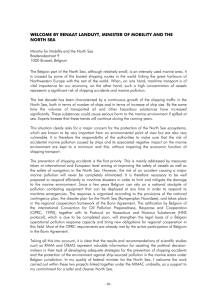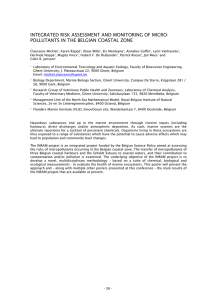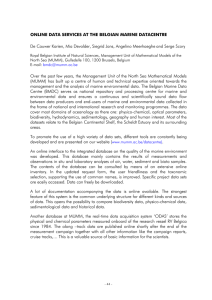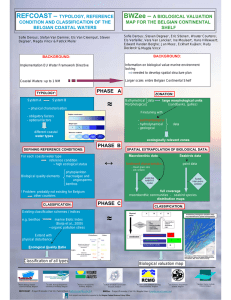Thierry G. Jacques SHAPING OF OPERATIONAL ARRANGEMENTS
advertisement
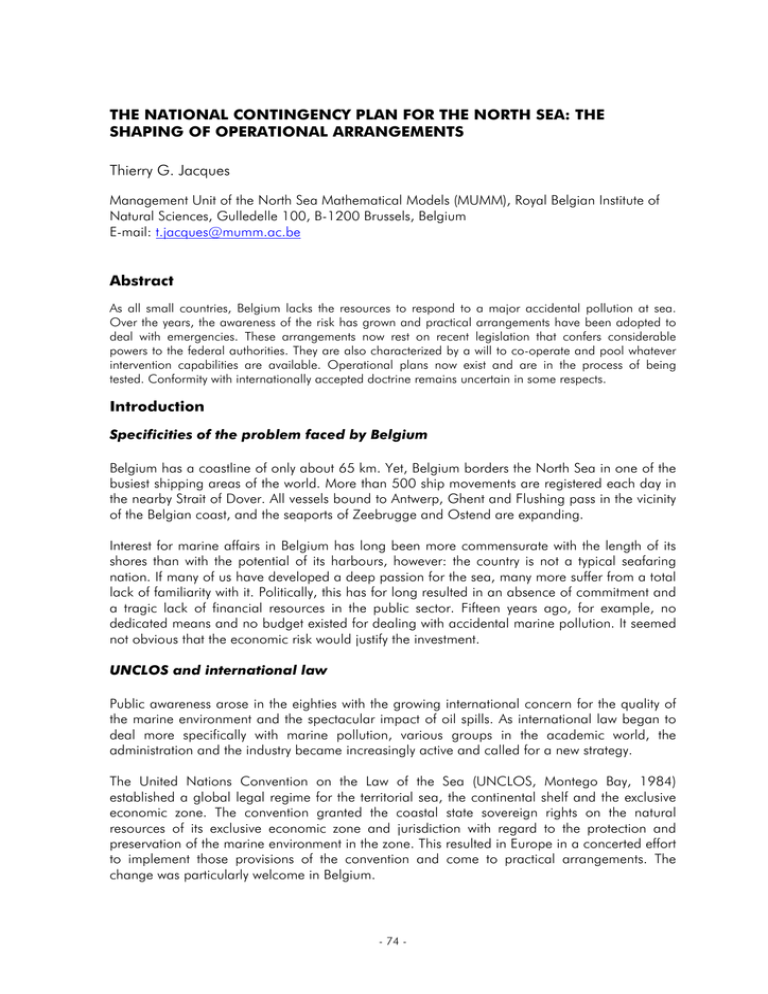
THE NATIONAL CONTINGENCY PLAN FOR THE NORTH SEA: THE SHAPING OF OPERATIONAL ARRANGEMENTS Thierry G. Jacques Management Unit of the North Sea Mathematical Models (MUMM), Royal Belgian Institute of Natural Sciences, Gulledelle 100, B-1200 Brussels, Belgium E-mail: t.jacques@mumm.ac.be Abstract As all small countries, Belgium lacks the resources to respond to a major accidental pollution at sea. Over the years, the awareness of the risk has grown and practical arrangements have been adopted to deal with emergencies. These arrangements now rest on recent legislation that confers considerable powers to the federal authorities. They are also characterized by a will to co-operate and pool whatever intervention capabilities are available. Operational plans now exist and are in the process of being tested. Conformity with internationally accepted doctrine remains uncertain in some respects. Introduction Specificities of the problem faced by Belgium Belgium has a coastline of only about 65 km. Yet, Belgium borders the North Sea in one of the busiest shipping areas of the world. More than 500 ship movements are registered each day in the nearby Strait of Dover. All vessels bound to Antwerp, Ghent and Flushing pass in the vicinity of the Belgian coast, and the seaports of Zeebrugge and Ostend are expanding. Interest for marine affairs in Belgium has long been more commensurate with the length of its shores than with the potential of its harbours, however: the country is not a typical seafaring nation. If many of us have developed a deep passion for the sea, many more suffer from a total lack of familiarity with it. Politically, this has for long resulted in an absence of commitment and a tragic lack of financial resources in the public sector. Fifteen years ago, for example, no dedicated means and no budget existed for dealing with accidental marine pollution. It seemed not obvious that the economic risk would justify the investment. UNCLOS and international law Public awareness arose in the eighties with the growing international concern for the quality of the marine environment and the spectacular impact of oil spills. As international law began to deal more specifically with marine pollution, various groups in the academic world, the administration and the industry became increasingly active and called for a new strategy. The United Nations Convention on the Law of the Sea (UNCLOS, Montego Bay, 1984) established a global legal regime for the territorial sea, the continental shelf and the exclusive economic zone. The convention granted the coastal state sovereign rights on the natural resources of its exclusive economic zone and jurisdiction with regard to the protection and preservation of the marine environment in the zone. This resulted in Europe in a concerted effort to implement those provisions of the convention and come to practical arrangements. The change was particularly welcome in Belgium. - 74 - Legal foundations of our response strategy On the initiative of the Belgian government, treaties were signed with France (law of 1993), the United Kingdom (law of 1993) and the Netherlands (law of 1998) to delimit the territorial seas and continental shelves. By law of 18 June 1998, Belgium ratified UNCLOS, which made it possible to establish an exclusive economic zone. The zone was created by law of 22 April 1999. Almost simultaneously, the Federal Government passed through Parliament the law of 20 January 1999 on the protection of the marine environment. That law set the frame of an integrated marine management strategy, including an entire body of principles with regard to the responsibilities of the polluter and the powers of the public authorities in maritime accidents. Meanwhile, many provisions of international law were confirmed and further developed in European legislation. Following directive 2002/59/EC, all Federal ministers responsible for operational aspects of counter-pollution response pursuant to the law of 20 January 1999 signed the decree of 19 April 2005 granting official status to the North Sea Emergency Plan placed under the coordination of the Governor of West-Flanders. On 8 July 2005, an Agreement setting up a joint cooperative Coast Guard Structure was signed by the Federal Government and the Flemish Region. With a joint communication system, a common secretariat and two levels of coordination, that Agreement set the stage for operational plans covering all aspects of the intervention of the coastal state at sea. Peculiarities of the response strategy in Belgium In the above legislation a number of features deserve to be pointed out as particularly interesting or unconventional. In line with the most recent directives, the polluter is expected to take initial measures to contain pollution, recover the pollutant, prevent damage and restore the affected resources. This being said, however: the authorities may intervene on a vessel ex officio, if they think it necessary; the polluter pays; the master of a polluting vessel is required to co-operate with the authorities; any of five different government services with authority at sea may do so; their actions and interactions are in principle governed by an operational plan; some decisions bearing a risk for nature conservation can only be made by a government scientist: the incident manager or the on-scene commander must obtain his authorization before using chemical treatment agents or before abandoning gear or intervention materials in the environment at sea; the criterion for such decisions is set down in the law: the chosen treatment should produce ‘a global reduction of the adverse effects of the pollution in the marine environment’ compared with other combating options or with the natural processes. Obviously, the intention of the legislator was to maximize the enforcement capabilities of a small coastal state by granting powers to many authorities at sea, and to coordinate those many in a single structure, making sure that this structure also associates the regional (local) authorities. The emphasis is on sound practice and the preservation of the marine environment. The intention is also to make up for the lack of means by pooling resources for intervention at sea and on the shore; and to make up for the dispersion of legal responsibilities of the various departments involved by adopting good sense, voluntary co-ordination schemes. For example, the control of shipping is essentially centralized at the regional Flemish Marine Rescue Coordination Centre in Ostend. The national level General response Coordinator of all actions at sea and ashore is the Governor of West-Flanders. The On-Scene commander afloat is a Navy officer representing the Admiral commanding the Belgian fleet. The operational arrangements Budgetary provisions for oil combating at sea were not made in the State budget until 1994. When they were made, they remained exceedingly modest (75.000 euros per year working - 75 - credit for nearly 10 years). A 2.5 million euros investment credit was first voted only in 2000. At the present time, no dedicated combating vessel is available yet to the authorities for operations at sea. Three operational plans have been adopted as subsidiaries of the national North Sea Emergency Plan: a plan for oiled birds, on 21 June 2005; a plan for cleanup operations along the shore, on 25 January 2006; and a plan for counter-pollution operations at sea, on 10 August 2006. All three plans recognize the authority of the Governor as General Co-ordinator. The operational plan for counter-pollution interventions at sea implements the principles of the general response strategy. The plan is placed under the coordination of the Federal Department of the Environment. After the evaluation of the situation and the initial counter-measures onscene, a choice is made of the most appropriate combating method. Pursuant to the law on the protection of the marine environment, the decision rests on a Net Environmental Benefit Analysis (NEBA) for which MUMM, a department of the Royal Belgian Institute of Natural Sciences, is responsible. The intervention develops along seven phases: (1) alarm, (2) assessment, (3) initial counter-measures, (4) choice of the combating strategy, (5) combating operations, (6) followup, and (7) debriefing. All components of these seven phases are structured in a flowchart that also serves as an index: for each component, reference is made to an explanatory fiche that expands the information. The plan places an emphasis on the need to search for and collate all the relevant information in one location in order to permit a valid NEBA assessment. Computer models used to simulate the natural processes and the behaviour of the pollutant are an essential tool for the assessment. The classical strategic choices (mechanical recovery, chemical dispersion, mechanical dispersion, do nothing) are explained in a flow chart and the emphasis is placed on the need for monitoring the operations (particularly if the do nothing option is selected!) and for providing aerial guidance to the intervening vessels. Basic provisions are made for temporary storage of recovered wastes and for disposal. The oiled birds plan deserves an analysis of its own and will not be commented on any further here. The operational plan for cleanup along the shore has also been prepared under the coordination of the Federal Department of the Environment. It recognizes the need to reconcile the arrangements for dealing with marine pollution with the Provincial Emergency Plan. As long as the shore pollution is limited to the coastline of a single municipality, the operational coordination is done by the local mayor. He can call on the assistance of the Civil Protection, a service of the Minister of the Interior. If the cleanup overlaps on the territory of two or several municipalities, the Governor is in charge of the co-ordination. A Province Policy Group brings together the Coordinator, the mayors and the Civil Protection. Critical evaluation of the current state of affairs As the dates show, the operational plans are very recent and they will require the trial of time and contingencies to show their adequacy. A priori, however, the plans appear sound and well organized, and they constitute a huge step forward from the situation that existed only two years ago. They are professional instruments and it should be no great problem, when needed, to further build on them. One cannot escape the impression, on the other hand, that these plans are well suited for medium-size spills (up to 1.000 tons of oil?) but that they would fail for large oil spills. The way in which the arrangements of the three operational plans integrate within the general arrangements of the North Sea Emergency Plan remains unclear. In particular, one misses here the traditional three-tier approach that has proven so useful in contingency planning world- 76 - wide. Structures appear rather dispersed and the responsibility for coordination shifts from one to the other, not only with scenarios, but also with the location and the phasing of the operations. In most cases, one gets the impression that the person in charge of the coordination is not an expert of counter-pollution but rather a high official endowed with administrative responsibilities. How this person will be assisted technically is unclear. The shore cleanup plan does not address the problem of organizing volunteers in a large-scale incident. Finally, logistics and finance do not seem to be centralized unless the Federal Department of the Environment takes the initiative. Rules enabling it – or another level of government – to do so and clear mechanisms for funding joint operations are most needed. There is an obvious need to reconcile the plans with the internationally recognized doctrine of contingency planning developed by the International Maritime Organization (IMO) and the Oil Pollution Response Convention (OPRC). Conclusion The current arrangements for dealing with emergencies at sea in Belgium rest on a sound, comprehensive body of legislation that evolved in less than a decade and shows a number of interesting, original features. There is an obvious attempt to reconcile a chronic lack of resources with the will of the coastal state to be present at sea and to be in control. The environmental concern is central to the contingency plans, and a resolute effort is made to found strategic choices on an expert assessment of impacts and a scientific approach of environmental benefits. The latest operational plans contribute decisively to the preparedness of the organization. They will need to be further aligned on the accepted international doctrine and scaled up to face major pollution disasters. Budgetary provisions, expert advice and dedicated sea-going platforms will most certainly be required. - 77 -
